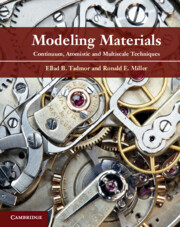Book contents
1 - Introduction
Published online by Cambridge University Press: 05 June 2012
Summary
As we explained in the preface, modeling materials is to a large extent an exercise in multiscale modeling. To set the stage for the discussion of the various theories and methods used in the study of materials behavior, it is helpful to start with a brief tour of the structure of materials – and in particular crystalline materials – which are the focus of this book. In a somewhat selective way, we will discuss the phenomena that give rise to the form and properties of crystalline materials like copper, aluminum and steel, with the goal of highlighting the range of time and length scales that our modeling efforts need to address.
Multiple scales in crystalline materials
Orowan's pocket watch
The canonical probe of mechanical properties is the tensile test, whereby a standard specimen is pulled apart in uniaxial tension. The force and displacement are recorded during the test, and usually normalized by the specimen geometry to provide a plot of stress versus strain. In the discussion of an article by a different author on “the significance of tensile and other mechanical test properties of metals,” Egon Orowan states: [Oro44]
The tensile test is very easily and quickly performed, but it is not possible to do much with its results, because one does not know what they really mean. They are the outcome of a number of very complicated physical processes taking place during the extension of the specimen. […]
- Type
- Chapter
- Information
- Modeling MaterialsContinuum, Atomistic and Multiscale Techniques, pp. 1 - 18Publisher: Cambridge University PressPrint publication year: 2011



